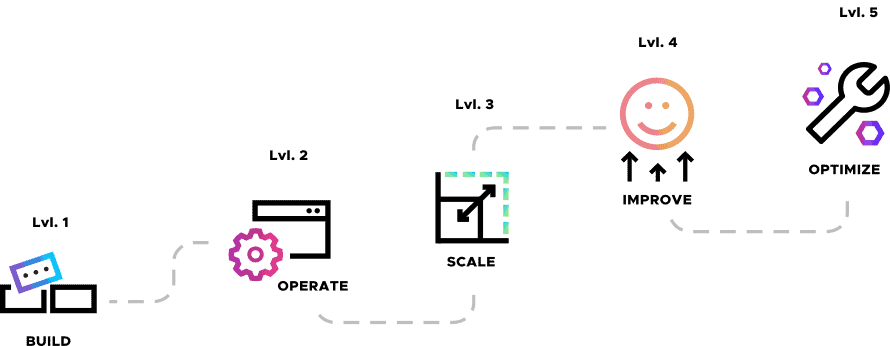Every cloud native journey begins with provisioning—the tools responsible for automatically configuring, creating, and managing cloud native infrastructure. Technology leaders must navigate the CNCF Landscape’s provisioning layer—which includes mission-critical subcategories like automation & configuration, container registries, security & compliance, and key management—to guide their teams in building proof of concept (POC) deployments and experiments.
Leaders who have locked in their provisioning tool choices can move their organization into production. Developers and engineers then quickly need to develop more sophisticated practices for deploying cloud native applications in a resilient, cost-effective, and productive way.
As they search for strategies that will guide their long-term scaling and optimization improvements, leaders first need a reliable framework for understanding the maturity of what they already have—that’s the only way to see where new opportunities lie.
These concepts of provisioning and maturity anchored the second-ever CTO Summit, held in parallel to KubeCon + CloudNativeCon North America 2022, where a diverse group of 21 technology leaders convened for an open-ended, in-depth, and candid conversation about the essential role of maturity in their cloud native journeys.
We’ve just released the full report based on this extended conversation, Exploring the Foundations of Cloud Native Maturity, for anyone in the cloud native community to explore and learn from. Instead of reinventing the wheel, you can define the strategies used to move your cloud native journey forward based on the standards and goals our end user leaders have validated in the real world.
In this CTO Summit report, you’ll learn how end user organizations are already:
- Driving informed organizational strategies based on their cloud native maturity.
- Making more informed decisions around tool choice in the CNCF Landscape.
- Communicating the business value of cloud native transformation to non-technical peers and C-suite leadership.
- Building information-sharing councils to spread knowledge and best practices on complex topics like governance and security.
The CTO Summit’s participants, and this report, is largely based around the Cloud Native Maturity Model (CNMM). This emerging framework helps you assess the maturity of your organization’s cloud native journey and reveal opportunities for improvement and advancement. The CNMM aims to provide all stakeholders, whether a CTO or application developer, with a common language for continuous improvement.

The CNMM is under rapid development, with continuous feedback from the cloud native community, which allowed the diverse group of 21 technology leaders to share their experiences and shape the concept of cloud native maturity moving forward. They represented significant organizations in financial services, aerospace, automotive, e-commerce, media services, retail, lifestyle, manufacturing, and more. All owned the technical decision-making, budgeting, and platform/application KPIs for their organization’s cloud native journey.
We hope this report offers valuable insights into the gray areas you should avoid and the opportunities you’ll want to seize on your cloud native journey. You can also get directly involved in CNCF’s End User Community and the ongoing development of the CNMM.
- Learn learn more about the CNMM, which is helmed by the Cartografos Working Group (#cartografos-wg on CNCF’s Slack), by visiting their new webpage or their GitHub repo.
- Apply to join the CTO Summit at KubeCon + CloudNativeCon Europe in Amsterdam as we discuss FinOps concerns and how to use them within your organization.
Read Exploring the Foundations of Cloud Native Maturity now.